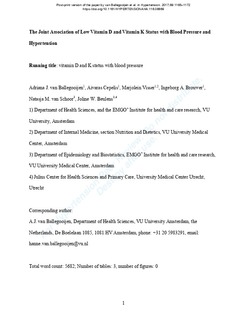| dc.contributor.author | Ballegooijen, A J van | |
| dc.contributor.author | Cepelis, Aivaras | |
| dc.contributor.author | Visser, Marjolein | |
| dc.contributor.author | Brouwer, Ingeborg A. | |
| dc.contributor.author | Van Schoor, Natasja M | |
| dc.contributor.author | Beulens, Joline W. J. | |
| dc.date.accessioned | 2019-05-07T13:00:16Z | |
| dc.date.available | 2019-05-07T13:00:16Z | |
| dc.date.created | 2018-05-24T19:00:41Z | |
| dc.date.issued | 2017 | |
| dc.identifier.citation | American Journal of Hypertension. 2017, 69 (6), 1165-1172. | nb_NO |
| dc.identifier.issn | 0895-7061 | |
| dc.identifier.uri | http://hdl.handle.net/11250/2596834 | |
| dc.description.abstract | Low vitamin D and K status are both associated with an increased cardiovascular risk. New evidence from experimental studies on bone health suggest an interaction between vitamin D and K; however, a joint association with vascular health outcomes is largely unknown. To prospectively investigate whether the combination of low vitamin D and K status is associated with higher systolic and diastolic blood pressure in 402 participants and with incident hypertension in 231 participants free of hypertension at baseline. We used data from a subsample of the Longitudinal Aging Study Amsterdam, a population-based cohort of Dutch participants aged 55 to 65 years. Vitamin D and K status were assessed by 25-hydroxyvitamin D and dp-ucMGP (dephosphorylated uncarboxylated matrix gla protein) concentrations (high dp-ucMGP is indicative for low vitamin K status) in stored samples from 2002 to 2003. Vitamin D and K status were categorized into 25-hydroxyvitamin D <50/≥50 mmol/L and median dp-ucMGP <323/≥323 pmol/L. During a median follow-up of 6.4 years, 62% of the participants (n=143) developed hypertension. The combination of low vitamin D and K status was associated with increased systolic 4.8 mm Hg (95% confidence interval, 0.1–9.5) and diastolic 3.1 mm Hg (95% confidence interval, 0.5–5.7) blood pressure compared with high vitamin D and K status (P for interaction =0.013 for systolic blood pressure and 0.068 for diastolic blood pressure). A similar trend was seen for incident hypertension: hazard ratio=1.62 (95% confidence interval, 0.96–2.73) for the low vitamin D and K group. The combination of low vitamin D and K status was associated with increased blood pressure and a trend for greater hypertension risk. | nb_NO |
| dc.language.iso | eng | nb_NO |
| dc.publisher | Oxford University Press (OUP) | nb_NO |
| dc.title | Joint Association of Low Vitamin D and Vitamin K Status With Blood Pressure and Hypertension | nb_NO |
| dc.type | Journal article | nb_NO |
| dc.type | Peer reviewed | nb_NO |
| dc.description.version | acceptedVersion | nb_NO |
| dc.source.pagenumber | 1165-1172 | nb_NO |
| dc.source.volume | 69 | nb_NO |
| dc.source.journal | American Journal of Hypertension | nb_NO |
| dc.source.issue | 6 | nb_NO |
| dc.identifier.doi | 10.1161/HYPERTENSIONAHA.116.08869 | |
| dc.identifier.cristin | 1586577 | |
| dc.description.localcode | This is a pre-copyedited, author-produced version of an article accepted for publication in [American Journal of Hypertension] following peer review. The version of record is available online at: https://doi.org/10.1161/HYPERTENSIONAHA.116.08869 | nb_NO |
| cristin.unitcode | 194,65,20,0 | |
| cristin.unitname | Institutt for samfunnsmedisin og sykepleie | |
| cristin.ispublished | true | |
| cristin.fulltext | original | |
| cristin.qualitycode | 1 | |
